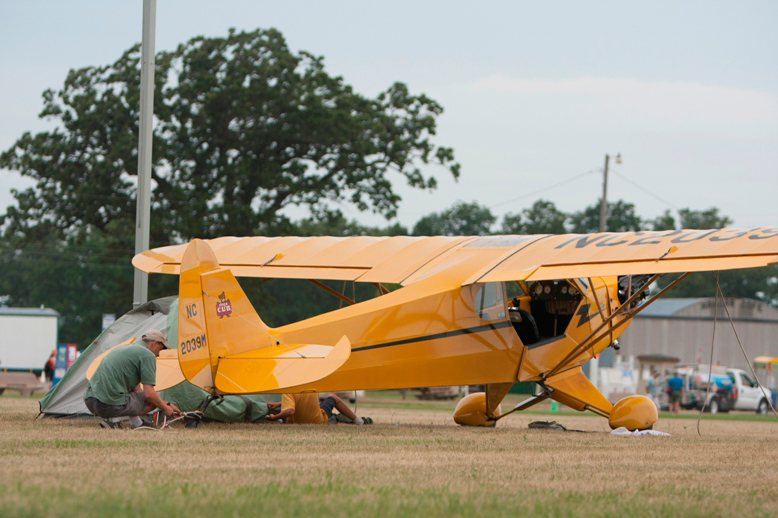Proper Tiedowns Ensure Your Aircraft Doesn’t Wander Off at Oshkosh
By Tim Fox, Vintage Aircraft Parking - EAA Volunteer Advisory Committee
June 2, 2016 - The proper tiedowns at Oshkosh have been discussed frequently and EAA has published several articles in its magazines and website on the topic. The concerns are the safety of people and their aircraft during AirVenture. This extends to all year round and everywhere aviation people meet.
In the past, we have seen all kinds of different tie-down systems used—some better than others and some that were laughable in their ineffectiveness. One thing is sure: at some time and at least once during the week, we will have a severe weather event. I’m sure everyone has a story about “that storm at Oshkosh.” The key thing to remember is that we care about our own planes, but should also be thinking about the plane next to us. Somebody like you cares about that airplane as much as you care about yours. If your plane moves into the plane next door, you and your insurance will be in the claims process for sure.
Airport and convention rules require you to bring or purchase tiedowns and use them when parking your aircraft at OSH. The ground personnel will remind you to tie down your plane. Everyone should be alert for an unsecured aircraft and contact officials if one is found.
What type of system is best? Everyone has their own opinion but most of the articles published by EAA point to a three-contact multi point system. In this system, there are contact points under each wing and the tail connected to the plane by ropes or straps. Each contact point is held in position by multiple (most commonly three) stakes driven into the ground at different angles to provide maximum ground securement. There are many of these systems available from the aircraft suppliers as well as plans if you want to make your own.
The second type consists of a single shaft driven in at an angle with tie-down ropes tied so that they are at an angle to the rod in the ground. At Oshkosh, EAA has two types of this tiedown available, one in the north supplied by EAA Chapter 444 and in the south by Camper Registration. Both are sold on site and if returned when departing, a partial refund can be obtained. Differences are that the north system uses a smooth bar shaft with an angled top that forces the pull on the tiedown to pull the rod sideways instead of straight out of the ground. The south uses a shaft made or ribbed rebar with a “T” handle at the top. This is driven into the ground so that the ropes again pull at an angle rather than straight up. One school of thought is that the ribbing on the rebar gives a better grip for the bar but both types have proven successful on the grounds at Oshkosh.
Less effective are the screw-in types of tiedowns sometimes referred to as “doggy stakes.” While these types of stakes seem to have good holding power, they are not as sturdy as the more substantial types mentioned. Each year, a few of screw-in tiedowns break, leaving a portion in the ground that requires digging out of the stake. In the event of a more substantial windstorm, these anchors are not always up to the task.
The bottom line on tiedowns is that whatever you use, you are not only protecting your own aircraft but the aircraft parked beside you. EAA volunteers are checking all aircraft for tiedowns after they arrive and will remind pilots that forget to use them. The last thing you or anyone wants is to be at the World’s Greatest Aviation Celebration and find yourself in a position where your ride home is broken because it came loose and struck another plane.
For further assistance in this area, contact your parking volunteers.

